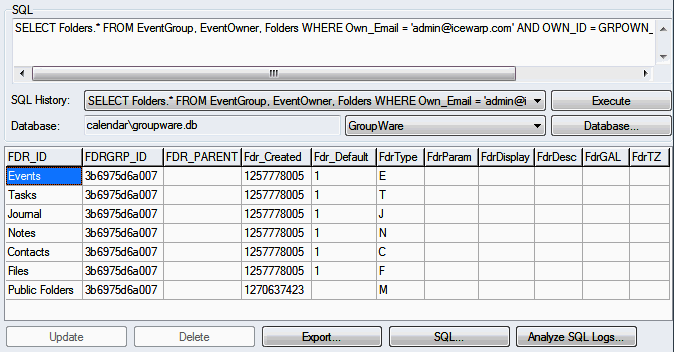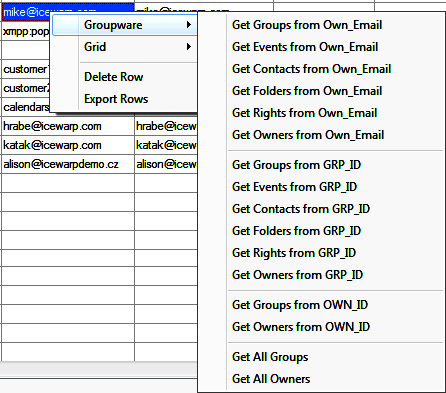SQL Manager
This tool can ease your work with IceWarp Server databases. It allows you to perform SQL queries and manage databases.
Note: You can use SQL Manager over Remote Connection Protocol (RCP) for remote servers. See Remote Server Administration.

Figure. SQL manager.
|
Field |
Description |
|---|---|
|
SQL |
Write an SQL query here. You can select one of pre-defined ones using the SQL button. |
|
SQL History |
You can select a query from the list of previous queries. |
|
Database (field) |
Path and name of the selected database. |
|
Database (list) |
Select a database type (GroupWare here). |
|
Database (button) |
Click the button to view or edit properties of the selected database. The standard Database dialog is shown. |
|
Result table |
Results of your query (found records) are shown here. |
|
Update |
Perform a change in a result row and click the button to update a database table. This button is enabled only after an SQL query that uses the Note: This button is enabled only after an SQL query that uses the SELECT * command and is directed only to one database table. E. g.: SELECT * FROM Event WHERE EVNOWN_ID = '3b6975d6f006' |
|
Delete |
Click the button to delete the current row from a database. Note: This button is enabled only after an SQL query that uses the SELECT * command and is directed only to one database table. E. g.: SELECT * FROM Event WHERE EVNOWN_ID = '3b6975d6f006' |
|
Export |
Click the button to export query results to a file. The standard Save As dialog is shown. |
|
SQL |
Click the button to select from the pre-defined SQL queries. Queries are same as in the figure bellow. Note: The Email Address dialog is shown – enter email address/GRP_ID/OWN_ID. |
|
Analyze SQL Logs |
Click the button to open a log file. Here you can analyze how much time single queries took. Logs are shown according to time in descending order. |
Pop-up Menu
Right-click any result row to reveal this menu. It can be used for selection of pre-defined SQL statements. It also allows you to delete a selected row or export it to a .csv file.

Figure. SQL manager: Pop-up menu.

